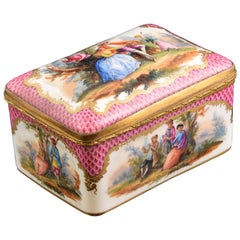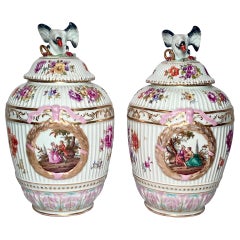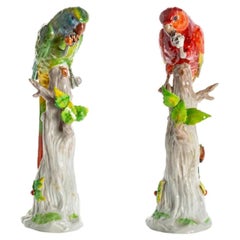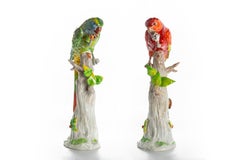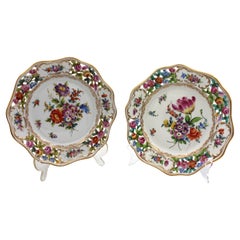Dresden Porcelain Marks
Antique Late 19th Century German Neoclassical Revival Decorative Boxes
Other
Antique Late 19th Century Jars
Porcelain
Antique 19th Century Figurative Sculptures
Porcelain
19th Century Figurative Sculptures
Porcelain
Antique 19th Century Austrian Porcelain
Early 20th Century German Arts and Crafts Dinner Plates
Ceramic, Porcelain
Dresden Porcelain Marks For Sale on 1stDibs
How Much are Dresden Porcelain Marks?
- Is Dresden always marked?1 Answer1stDibs ExpertApril 5, 2022No, Dresden is not always marked. Pieces made shortly after the company's founding in 1872 often bear no mark. A licensed appraiser can help you identify unmarked Dresden porcelain. On 1stDibs, shop a range of Dresden serveware and decorative objects.
- What is the Dresden china mark?1 Answer1stDibs ExpertAugust 8, 2024There is no single Dresden porcelain mark because, over the years, the German maker employed many different markings to identify its pieces. Many pieces feature the letter N or a crown, while some display both. Dresden also used its wordmark with and without an image of a lamb. To determine whether a marking on a particular piece indicates Dresden porcelain, look up the mark using trusted online resources or enlist the services of a certified appraiser. On 1stDibs, find a wide range of Dresden porcelain.
- 1stDibs ExpertApril 22, 2024The famous porcelain from Dresden is usually just referred to as Dresden porcelain. However, its maker is Sächsische Porzellan-Manufaktur Dresden GmbH, which translates to Saxon Porcelain Manufactory in Dresden Ltd. The company opened in Potschappel, a suburb of Freital in the Sächsische Schweiz-Osterzgebirge district of Dresden, in 1872. Find a variety of Dresden porcelain on 1stDibs.
- 1stDibs ExpertMay 3, 2024The history of Dresden Porcelain began with the founding of Sächsische Porzellanmanufaktur Dresden by Carl-Johann Gottlob Thieme in 1872 in the city of Freital, Saxony. During the decades that followed, his son-in-law Carl August Kuntzsch joined the company and pioneered the process of adding ornate floral ornamentation to porcelain. When Thieme died in 1912, Kuntzsch took up the reins of Dresden Porcelain. The company saw a decline during World War I and II. During the period after the Second World War, the Soviet Union gradually assumed control of Dresden Porcelain, renaming it VEB Sächsische Porzellan-Manufaktur Dresden. The reunification of Germany in 1990 allowed the company to return to private ownership. A French investor group purchased it in 1991 and then sold it to the Dresden IPV group, led by art patron Jürgen Wegener, in 1993. Gunther Seifert and Klaus-Peter Arnold bought out the group following its bankruptcy in 1998, only to resell it to Geschwister Hillebrand GmbH in 2005. Explore a selection of Dresden Porcelain on 1stDibs.
- 1stDibs ExpertApril 5, 2022The Kangxi mark appears on porcelain created in China during the Kangxi period, 1662-1722. There are two types of Kangxi marks: a reign mark and a potter’s personal mark. Reign marks are six-character marks in two vertical lines with a double circle around them. Other marks vary and indicate a potter’s personal mark. They could be a picture, a blank circle or a character. Browse a variety of authenticated Kangxi porcelain on 1stDibs.
- 1stDibs ExpertSeptember 23, 2024There are a few ways to identify porcelain marks. The quickest method is photographing the marking and performing a reverse image search. Often, this approach will allow you to quickly identify the maker of your porcelain. Alternatively, you can type a short description of the mark into a search engine or review trusted reference websites that show images of popular makers’ markings. If these approaches don't provide you with enough information to make a confident identification, a certified appraiser or knowledgeable antique dealer can assist you. On 1stDibs, find a large selection of porcelain.
- 1stDibs ExpertApril 5, 2022To identify German porcelain marks, use an authoritative online resource. If the mark contains words, enter them into a search engine surrounded by quotation marks. Otherwise, enter a description of the mark. You can also seek the advice of a licensed appraiser. Shop a collection of expertly vetted German porcelain on 1stDibs.
- 1stDibs ExpertApril 5, 2022Yes, Sevres porcelain is always marked. Sevres is known for a double L mark that features an interlocking shape with a year or symbol to denote the year produced within the design. Shop a selection of authenticated Sevres porcelain goods on 1stDibs.
- 1stDibs ExpertAugust 20, 2024To identify Chinese porcelain marks, consult trusted online resources. Most markings on Chinese porcelain consist of four to six characters, and the last two often represent when a piece was produced. Since there is a lot of variation in the markings, looking at images shared on trustworthy websites is the best way to make an identification. Alternatively, you can use the services of a certified appraiser or knowledgeable antique dealer. On 1stDibs, explore a wide range of Chinese porcelain.
- 1stDibs ExpertSeptember 23, 2024One way to identify French porcelain marks is to take a photo with your smartphone or tablet and then perform a reverse image search. Often, doing so will allow you to quickly determine the maker. If this approach fails, explore trusted online resources with photographs of the markings associated with various French makers, such as the crowned N of Sèvres and the H & Co. insignia of Haviland. Another option is to have a certified appraiser or knowledgeable antique dealer perform the identification for you. On 1stDibs, find a wide variety of French porcelain.
- 1stDibs ExpertNovember 4, 2024To identify Furstenberg pottery marks, use the official Furstenberg website, where you'll find a reference guide that makes interpreting the markings on your pottery simple. Most pieces feature a blue or green “F” mark under the glaze. On the bottom, you will also normally find stamped numbers representing the motif and decoration techniques and fainter, raised letters or numbers corresponding to the specific artisan who made it. If you run into any difficulty using the brand's official reference guide, a certified appraiser or knowledgeable antique dealer can be of assistance. On 1stDibs, shop a collection of Furstenberg pottery.
- 1stDibs ExpertNovember 26, 2024To identify Staffordshire porcelain marks, first look to see if your piece has a loosely knotted rope logo. Some items produced in Staffordshire bear this mark. Many pieces also feature a second or alternate maker's mark corresponding to the factory that produced it, such as Spode, Minton and Wedgwood. Online reference guides published on trusted websites can help you determine who made your piece based on these markings. Keep in mind that some Staffordshire porcelain is completely unmarked. If you can't locate a marking, consider having a certified appraiser or knowledgeable antique dealer assist you. Explore a wide variety of Staffordshire porcelain on 1stDibs.
- 1stDibs ExpertMarch 15, 2024To identify French Limoges porcelain marks, refer to trusted online resources. There are dozens of markings associated with Limoges porcelain. By comparing the marks on your piece to images shared online, you can determine if your piece is a Limoges. A certified appraiser or knowledgeable antiques dealer can also assist you with identification. Explore a range of Limoges porcelain on 1stDibs.
Read More
20 Inviting Dining Rooms Perfectly Arranged for Entertaining
Top interior designers show — and tell — us how to create delectable spaces for hosting dinner parties.
Paul Revere Crafted This Silver Coffee Pot 250 Years Ago
Perhaps best known as a Revolutionary War hero, Revere was also an accomplished silversmith, and this pot is now available on 1stDibs.
From Arne Jacobsen to Zaha Hadid, Top Designers Tackle Tableware
Clever objects like these make feasting even more festive.
How the Chunky, Funky Ceramics of 5 Mid-Century American Artists Balanced Out Slick Modernism
Get to know the innovators behind the pottery countercultural revolution.
Ready for a Cinderella Moment? This Glass Handbag Is a Perfect Fit
Glass slippers might be the stuff of fairytales, but glass handbags? Artist Joshua Raiffe has made them a reality, and they're far less delicate than you might imagine, but just as dreamy.
With Dansk, Jens Quistgaard Delivered Danish Simplicity to American Tables
When a visionary Copenhagen designer teamed up with an enterprising Long Island couple, Scandi-style magic landed in kitchens and dining rooms across the United States.
Hostess Extraordinaire Aerin Lauder Shares Entertaining Tips and Auction Picks
The arbiter of good taste, who has curated a collection for 1stDibs Auctions, invites 1stDibs inside her family’s Hamptons barn for a firsthand look at her welcoming style.
Handmade with Lab-Grade Glass, This Decanter Holds Your Favorite Cocktail Concoctions
Artist Simone Crestani conjures the fascination you remember from Chemistry 101.
